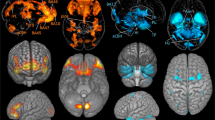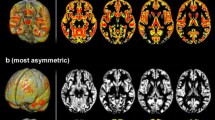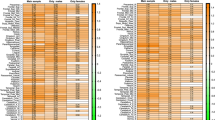Abstract
Gender differences in brain structure and function have long been an interest to neuroscientists. One region where these differences have been reported is in the band of white matter that connects the two cerebral hemisphere, the corpus callosum. The current study explores the possibility that differences in cognitive ability contribute to the observed gender effects. The focus here is on visuo-spatial processing as measured by mental rotation which has also been found to have significant gender differences. The results reported show that two segments of the corpus callosum revealed gender differences, the rostrum and the anterior midbody. Both segments connect cortical regions that have been implicated in mental rotation. Additionally, the gender effect found in the rostrum appears to be due to visuo-spatial processing while the anterior midbody appears to be affected by both visuo-spatial processing and gender. These results suggest that because neural structure and cognition are intimately intertwined, cognition should be accounted for when making group comparisons of neural structure.




Similar content being viewed by others
References
Anderson, J. R. (2000). Cognitive psychology and its implications. New York: Worth Publishers.
Barnes, J., Ridgway, G. R., Bartlett, J., Henley, S. M., Lehmann, M., Hobbs, N., … Fox, N. C. (2010). Head size, age and gender adjustment in MRI studies: a necessary nuisance? Neuroimage, 53, 1244–1255.
Baroody, A. E., & Diamond, K. E. (2012). Links among home literacy environment, literacy interest, and emergent literacy skills in preschoolers at risk for reading difficulties. Topics in Early Childhood Special Education, 32(2), 78–87.
Bishop, K. M., & Wahlsten, D. (1997). Sex differences in the human corpus callosum: myth or reality? Neuroscience and Biobehavioral Reviews, 21, 581–601.
Carpenter, P. A., Just, M. A., Keller, T. A., Eddy, W. F., & Thulborn, K. R. (1999). Graded functional activation in the visuo-spatial system with the amount of task demand. Journal of Cognitive Neuroscience, 11, 9–24.
Chao, L. L., & Martin, A. (2000). Representation of man-made objects in the dorsal stream. Neuroimage, 12, 478–484.
Crucian, G. P., & Berenbaum, S. A. (1998). Sex differences in right hemisphere tasks. Brain Cognit., 36, 377–389.
Curtis, C. E. (2006). Prefrontal and parietal contributions to spatial working memory. Neuroscience, 139(1), 173–180.
de Lacoste, M. C., Kirkpatrick, J. B., & Ross, E. D. (1985). Topography of the human corpus callosum. Journal of Neuropathology and Experimental Neurology, 44, 578–591.
DeLacoste-Utamsing, C., & Holloway, R. L. (1982). Sexual dimorphism in the human corpus callosum. Science, 216, 1431–1432.
Driesen, N. R., & Raz, N. (1995). The influence of sex, age, and handedness on corpus callosum morphology: a meta-analysis. Psychobiology, 23, 240–247.
Giedd, J. N., Castellanos, F. X., Casey, B. J., Kozuch, P., King, A. C., Hamburger, S. D., et al. (1994). Quantitative morphology of the corpus callosum in attention deficit hyperactivity disorder. American Journal of Psychiatry, 151, 665–669.
Greces, J., & Decety, J. (2002). Does visual perception of object afford action? Evidence from a neuroimaging study. Neuropsychologia, 40(2), 212–222.
Greenough, W. T., Black, J. E., & Wallace, C. S. (1987). Experience and brain development. Child development, 58, 539–559.
James, K. H., & Gauthier, I. (2006). Letter processing automatically recruits a sensory-motor brain network. Neuropsychologia, 44, 2937–2949.
Jordan, K., Wüstenberg, T., Heinze, H. J., Peters, M., & Jäncke, L. (2002). Women and men exhibit different cortical activation patterns during mental rotation tasks. Neuropsychologia, 40(13), 2397–2408.
Just, M. A., & Carpenter, P. A. (1985). Cognitive coordinate systems: accounts of mental rotation and individual differences in spatial ability. Psychological Review, 92(2), 137.
Keller, T. A., & Just, M. A. (2009). Altering cortical connectivity: remediation-induced changes in the white matter of poor readers. Neuron, 64(5), 624–631.
Linn, M. C., & Petersen, A. C. (1985). Emergence and characterization of sex differences in spatial ability: a meta-analysis. Child Development, 56, 1479–1498.
Luders, E., Narr, K. L., Zaidel, E., Thompson, P. M., & Toga, A. W. (2006). Gender effects on callosal thickness in scaled and unscaled space. Neuroreport, 17, 1103–1106.
Luders, E., Toga, A. W., & Thompson, P. M. (2014). Why size matters: differences in brain volume account for apparent sex differences in callosal anatomy: the sexual dimorphism of the corpus callosum. Neuroimage, 84, 820–824.
Mason, R. A., Williams, D. L., Kana, R. K., Minshew, N., & Just, M. A. (2008). Theory of mind disruption and recruitment of the right hemisphere during narrative comprehension in autism. Neuropsychologia, 46(1), 269–280.
Menzler, K., Belke, M., Wehrmann, E., Krakow, K., Lengler, U., Jansen, A., & Knake, S. (2011). Men and women are different: diffusion tensor imaging reveals sexual dimorphism in the microstructure of the thalamus, corpus callosum and cingulum. Neuroimage, 54(4), 2557–2562.
Newman, S. D., Carpenter, P. A., Varma, S., & Just, M. A. (2003). Frontal and parietal participation in problem-solving in the Tower of London: fMRI and computational modeling of planning and high-level perception. Neuropsychologia, 41(12), 1668–1682.
Newman, S. D., Greco, J. A., & Lee, D. (2009). An fMRI study of the Tower of London: a look at problem structure differences. Brain Research, 1286, 123–132.
Newman, S. D. & Just, M. A. (2005). The neural bases of intelligence: a perspective based on functional neuroimaging. In R. Sternberg, J. Davidson & J. Pretz, (Eds.), Cognition & Intelligence. New York: Cambridge University Press.
Newman, S. D., & Malaia, E. (2013). Neural bases of giftedness. In J. A. Plucker & C. M. Callahan (Eds.), Critical Issues and practices in gifted education (2nd ed.). Waco: Prufrock Press.
Niklas, F., & Schneider, W. (2012). Home Literacy Environment and the beginning of reading and spelling. Contemporary Educational Psychology, 38(1), 40–50.
Siegler, R. S. (1998). Children’s thinking. Upper Saddle River: Prentice-Hall.
Tracy, D. M. (1987). Toy-playing habits, spatial ability, science and mathematics achievement: are they related? Sex Roles, 17, 115–138.
Tracy, D. M. (1990). Toy-playing behavior, sex-role orientation, spatial ability, and science achievement. Journal of Research in Science Teaching, 27(7), 637–649.
Uttal, D. H., Meadow, N. G., Tipton, E., Hand, L. L., Alden, A. R., Warren, C., & Newcombe, N. S. (2013). The malleability of spatial skills: a meta-analysis of training studies. Psychological Bulletin, 139(2), 352.
Vandenberg, S. G. (1971). Mental rotation test. Boulder: University of Colorado.
Wai, J., Lubinski, D., & Benbow, C. P. (2009). Spatial ability for STEM domains: aligning over 50 years of cumulative psychological knowledge solidifies its importance. Journal of Educational Psychology, 101(4), 817.
Wai, J., Lubinski, D., Benbow, C. P., & Steiger, J. H. (2010). Accomplishment in science, technology, engineering, and mathematics (STEM) and its relation to STEM educational dose: a 25-year longitudinal study. Journal of Educational Psychology, 102(4), 860.
Wang, X., Casadio, M., Weber, K. A., Mussa-Ivaldi, F. A., & Parrish, T. B. (2014). White matter microstructure changes induced by motor skill learning utilizing a body machine interface. Neuroimage, 88, 32–40.
Weiss, E., Siedentopf, C. M., Hofer, A., Deisenhammer, E. A., Hoptman, M. J., Kremser, C., Golaszewski, S., Felber, S., Fleischhacker W. W., & Delazer, M. (2003). Sex differences in brain activation pattern during a visuospatial cognitive task: A functional magnetic resonance imaging study in healthy volunteers. Neuroscience letters, 344(3), 169–172.
Witelson, S. F. (1989). Hand and sex differences in the isthmus and genu of the human corpus callosum: a postmortem morphological study. Brain, 112, 799–835.
Voyer, D., Voyer, S., & Bryden, M. P. (1995). Magnitude of sex differences in spatial abilities: a meta-analysis and consideration of critical variables. Psychological Bulletin, 117(2), 250–270.
Author information
Authors and Affiliations
Corresponding author
Ethics declarations
Ethical approval
All procedures performed in studies involving human participants were in accordance with the ethical standards of the institutional and/or national research committee and with the 1964 Helsinki declaration and its later amendments or comparable ethical standards.
Conflict of interest
The authors declare that they have no conflict of interest.
Informed consent
Informed consent was obtained from all individual participants included in the study.
Rights and permissions
About this article
Cite this article
Newman, S.D. Differences in cognitive ability and apparent sex differences in corpus callosum size. Psychological Research 80, 853–859 (2016). https://doi.org/10.1007/s00426-015-0688-3
Received:
Accepted:
Published:
Issue Date:
DOI: https://doi.org/10.1007/s00426-015-0688-3




